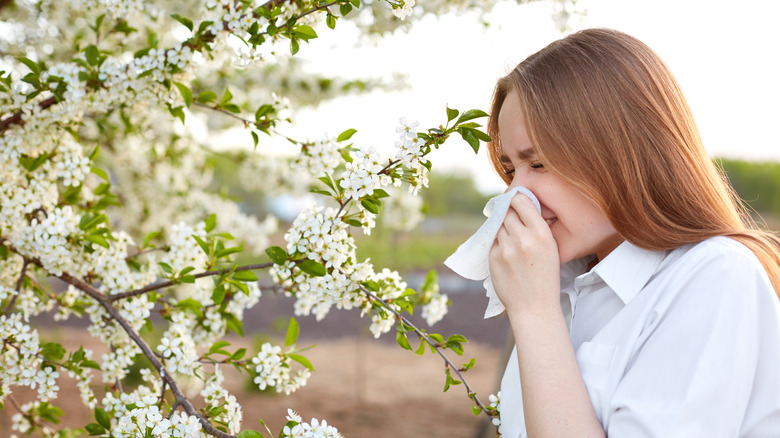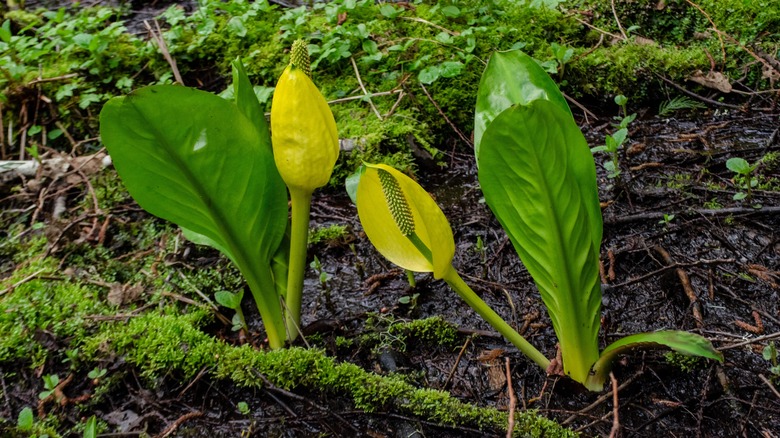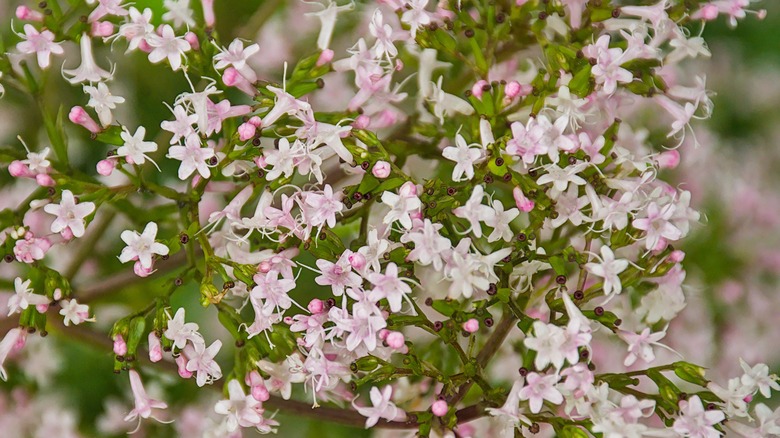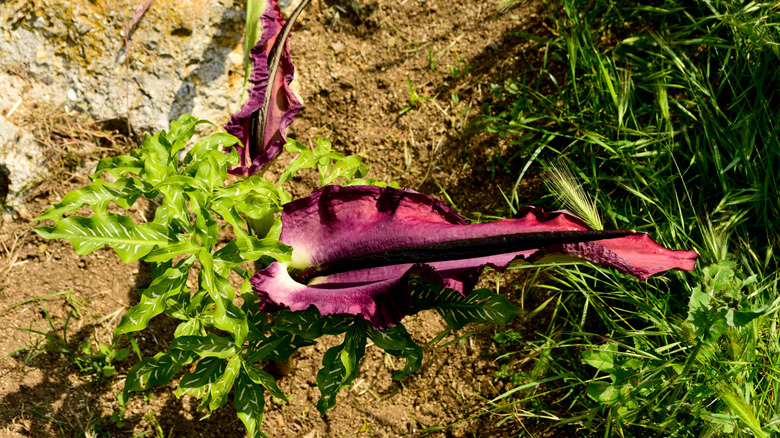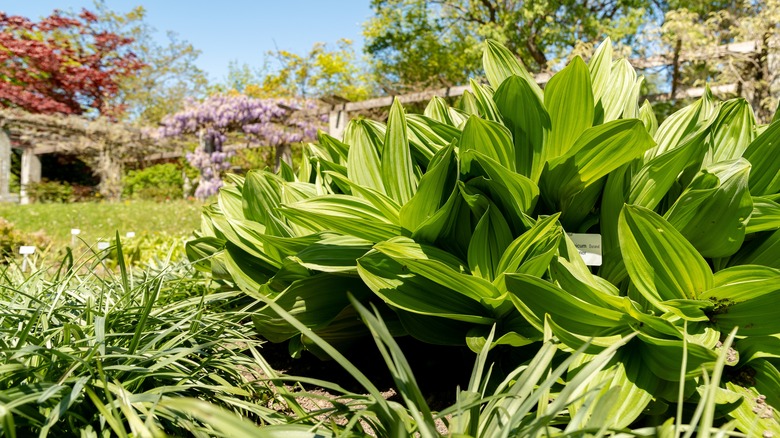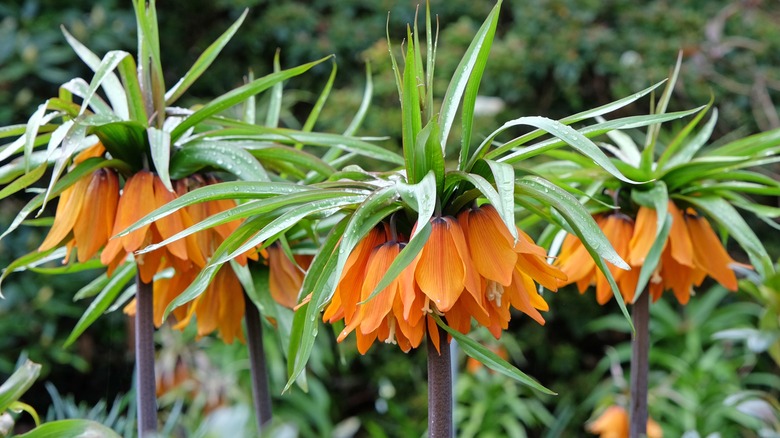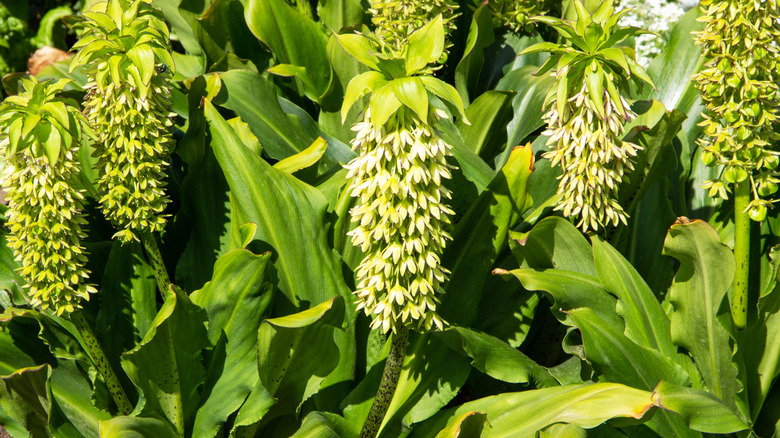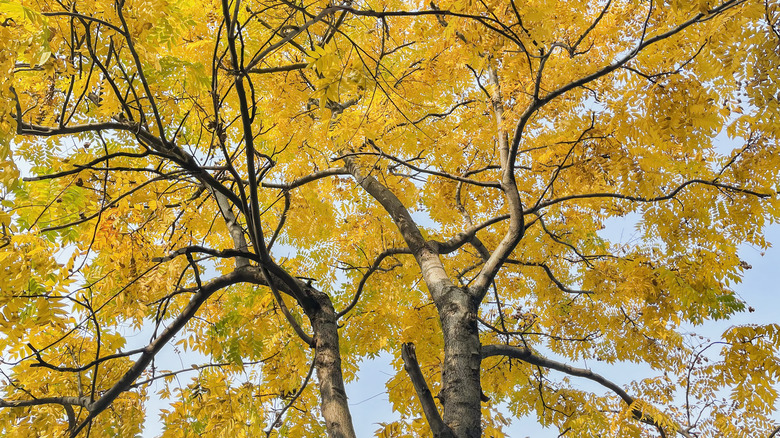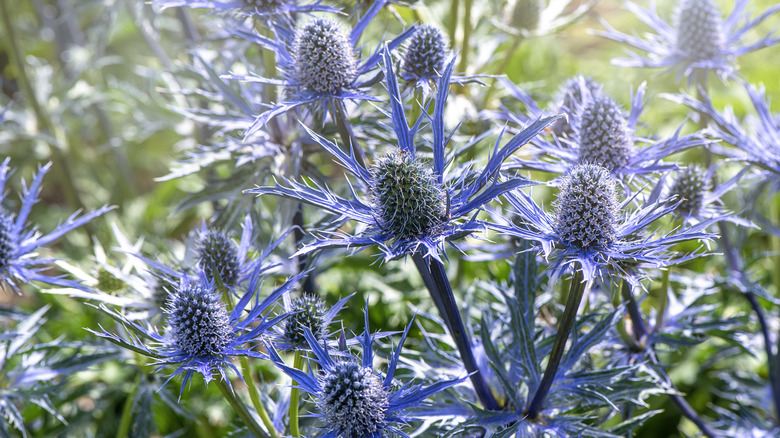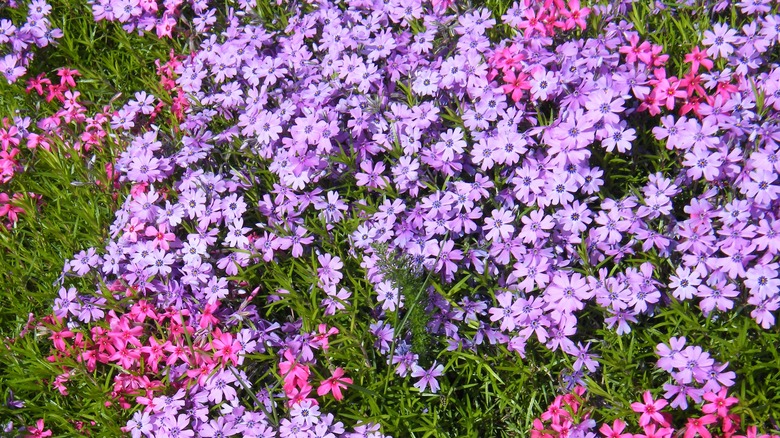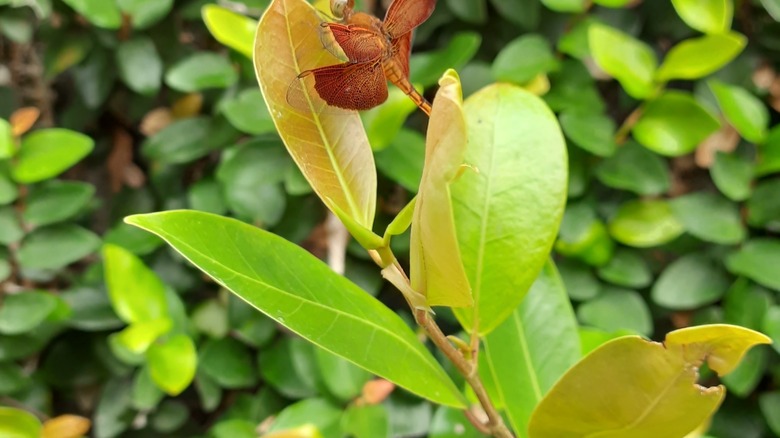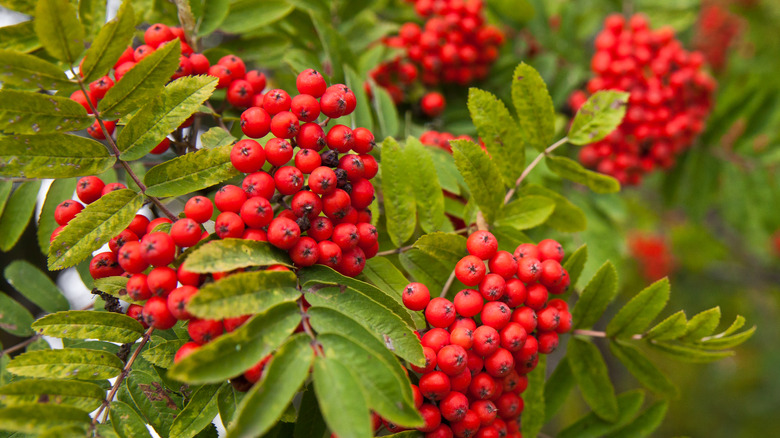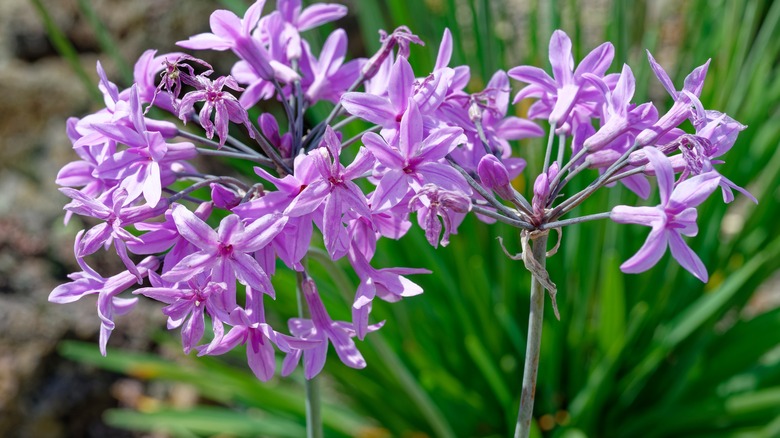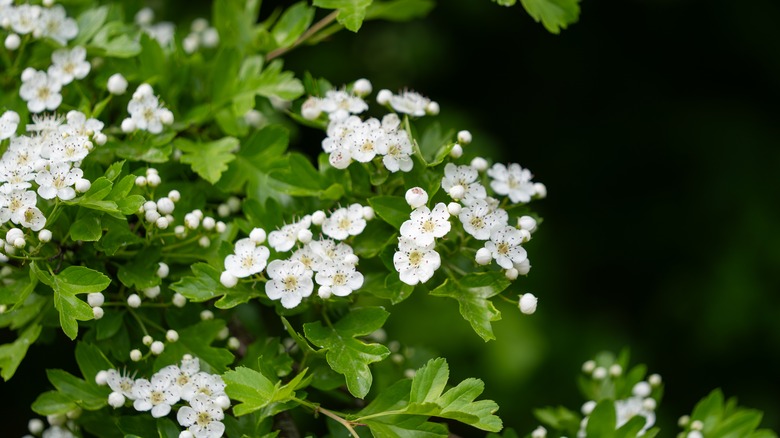13 Beautiful Plants That Could Be Causing That Awful Smell In Your Yard
What's the first thing you do when you're handed a bouquet of flowers? After you've jokingly questioned your partner about what they might be apologizing for, you probably lean in to enjoy the sweet fragrance. It's second nature to take a sniff of flowers since they're synonymous with a pleasant perfume. So, if your garden is in full bloom but you're getting a whiff of something revolting, it couldn't be the flowers ... could it? As it turns out, it could.
Unfortunately, not all flowers smell like roses. In fact, there are a number of visually stunning plants that could lure us into a false sense of security with their beautiful blooms, but if you get too close you'll notice they have a stinky secret. If your nose is sensitive to skunky smells, there are several plants you'll want to avoid growing in your garden. Some of the worst offenders include, unsurprisingly, the American skunk cabbage plant, dragon arum, and sea holly. With aromas likened to rotting meat, sweaty socks, and even vomit, this list of awful-smelling plants could literally cause quite a stink.
Aptly-named American skunk cabbage smells like rotten meat
American skunk cabbage (Lysichiton americanus) is also known as "skunk weed," and as you might expect from its common name, it emits an odor that many people find unpleasant. The smell of this plant has been likened to that of putrid meat, garlic, fresh cabbage, skunk, and mustard. This is certainly a plant you want to avoid growing in your yard if you're offended by a strong stench, but there's actually another reason you should kill skunk weed that has nothing to do with its smell: It's incredibly toxic to both humans and animals. If accidentally ingested, it can make your tongue and mouth swell and create a choking feeling in your throat. If large amounts are swallowed, it can even be fatal.
American skunk cabbage offers many benefits gardeners are looking for. For example, it can bloom incredibly early in the season, adding interest to the landscape as soon as January and February. It is also able to survive in a wide range of conditions, such as full shade or full sun. Skunk weed flowers have an incredible ability to maintain a temperature of between 70 and 77 degrees Fahrenheit, allowing them to melt the snow and ice around them so that their leaves won't be blocked from emerging out of the soil. Unfortunately, despite the advantages it can bring to the garden, growing this plant might not be the best idea, even if you can get over the smell. In addition to it being toxic, it is also considered invasive, and therefore should be avoided.
Valerian can make your yard smell like sweaty socks
The smell of the valerian plant (Valeriana officinalis) has been utilized throughout history in various ways, though none of which would be useful to the modern gardener. The Guardian reports that Romani people used it to calm dogs, and its alluring smell to animals meant that it was once popularly used as bait in rat and mice traps, too. However, unless you're partial to the pungent scent of sweaty socks, this is likely a plant you want to avoid in your yard (though there are a few benefits we'll go over next). In addition to the stinky situation, valerian is also considered an invasive species in some areas.
Though a plant that makes you want to gag every time you inhale might not sound like a prime candidate for your flower bed, you might not want to rule it out completely from your garden design. If it's not invasive in your area, you might want to consider planting it in a corner of your garden further away from your patio or deck. Valerian blooms are attractive in shades of pink and white, and the plant is also a popular herbal remedy. In fact, growing this beautiful flower might be able to improve your sleep. Touted as a cure for insomnia, valerian was once known as "the Valium of the 19th century," and was given to WW1 shell shock victims. You can make your own valerian tea by digging up the roots of the plant, allowing them to dry, and then grinding them down to fit into a steeper. Soak them in hot water for 10 minutes, and then drink an hour before bedtime.
That's not rotting meat you can smell. It's your dragon arum plant in bloom
Don't be fooled into thinking there's a decaying dead animal hiding in your shrubbery. If you're growing a dragon arum plant (Dracunculus vulgaris), then it's highly likely to be the culprit of any foul smells that are lingering in your garden. Also known as the voodoo lily, the flowers of the dragon arum give off an odor likened to decaying flesh. It might be helpful to know that the foul stench is at its strongest in the first 24 hours of blooming, and the reason for this comes down to survival. Since this plant is pollinated by flies, it produces a scent much like rotting meat to attract its pollinators — quite literally like flies to dung.
If you're a fan of dramatic plants, then it might be worth putting up with the foul-smelling blooms of the dragon arum to enjoy the floral display it puts on every year. The deciduous perennial sends out deep purple flowers in spring and summer that measure up to 2 feet in length, creating a striking focal point. Position it towards the back of flower beds to keep the offensive smell at a distance. However, if you have pets roaming the garden, you might want to think twice, because the dragon arum is poisonous. It can also irritate the skin, so wear gloves when handling.
Corn lily emits a musty scent
Corn lily (Veratrum californicum) is also commonly known as "false skunk cabbage," because it gives off an odor that is very similar to actual skunk cabbage. The stench is most intense in very dry weather when the plant begins to wither. Despite the fact that corn lily produces tall, pretty flower spikes in shades of cream throughout summer, it is most certainly a plant that should be avoided. The offensive smell the corn lily gives off is actually the least of your worries if this plant is growing in your garden. It is extremely toxic and can cause fatalities.
According to Westminster University, every part of the corn lily plant, from the roots to the tips of the leaves, is toxic. The poisonous compounds are steroidal alkaloids, with cyclopamine being the most dangerous. The extreme toxicity of the corn lily was first observed in the 1950s when Colorado farmers noticed that sheep who were grazing on corn lilies were giving birth to lambs with only one eye. Birth defects have been found in both livestock and rats due to corn lily plants. To keep your family and your pets safe, it is advisable to avoid growing corn lily, and carefully remove any that is already existing in your garden.
That garlic smell is actually your crown imperial plant
If you've been catching a whiff of a garlic-like scent in your garden, your crown imperial plant (Fritillaria imperialis) could be the culprit. The odor of the crown imperial plant is more skunky than garlicky, but either way, it's certainly not a scent humans are likely to be drawn to. While most people don't want their garden to smell unpleasant, you could actually use the icky scent to your advantage, because the underutilized spring bulb can be added to your garden to repel rabbits and other pests. Both the bulb and flowers of the plant emit a strong odor that wildlife, such as deer and squirrels, find offensive, making the crown imperial plant naturally pest-resistant.
On top of being a natural pest deterrent, crown imperial plants are also beautiful and easy to care for. If you would like to include them, consider planting them somewhere further away from your back door, patio, or walkways so you can enjoy their aesthetic and not be deterred by their smell. The flower stalks of the plants grow to around 3 feet tall, and a circle of bell-like blooms hang from the top of the stalk like a halo of bright color. The blooms typically come in shades of orange, red, and yellow, and they bloom in spring and summer. They grow best in fertile, well-draining soil, and will appreciate a spot in a sunny position. Once established, the plants are drought-tolerant and require little maintenance.
The rotting meat smell of the pineapple lily is at odds with its pretty flowers
Pineapple lilies (Eucomis sp.) are undeniably beautiful, which seems to contradict the simply awful rotting meat and vegetable smell they emit. When flowers produce a smell that is distasteful to humans but appealing to insects, it's usually a clever way to attract pollinators. However, some pineapple lilies have been confusing researchers with their gross smell, because they don't appear to be pollinated by insects. A study published by the New Phytologist Foundation instead found that some stinky species of pineapple lily were being pollinated by small mammals who transferred the pollen on their snouts. Mammals like mice and shrews were found to be especially attracted to the unusual sulfur compounds the pineapple lily contains, which are responsible for the rotten meat and potato smell.
If the scent of decaying meat isn't your thing, that doesn't mean you need to avoid pineapple lilies altogether. Some varieties don't smell at all, or claim to have a pleasant scent similar to coconuts. The stinkiest types you'll want to steer clear of include Eucomis comosa and Eucomis bicolor. Non-odorous types include 'Sparkling Burgundy' and 'Can Can.' And since these don't stink, they won't attract rodents to your yard, either. The bulbs are actually very easy to grow and care for. Plant them in spring in a sunny position in well-draining soil, and enjoy the tufts of flowers that bloom from August to October.
The female ginkgo tree smells remarkably like vomit
The female ginkgo tree (Ginkgo biloba) is one of the trees you might want to think twice about before planting in your yard. These trees produce fruits that contain butyric acid, which is the same chemical found in vomit and rancid butter. If you get too close to these fruits, you'll quickly understand why some people refer to the ginkgo tree as the "stinkgo tree." The scent of vomit coming from the female fruits is truly repulsive and is certainly a good enough reason to avoid growing this plant in the garden.
While ginkgo trees might come with certain disadvantages, they also have plenty of benefits to offer. The leaves of the tree are used to make ginkgo extract, which is high in antioxidants. In Chinese medicine, ginkgo extract is believed to help reduce inflammation, combat the signs of dementia, and reduce anxiety, so despite the gross smell, the tree is cultivated for this purpose. They are also exceptionally durable and are resistant to damage from storms. Plus if your garden suffers with compacted soil or poor drainage you can still successfully grow ginkgo trees because they will tolerate most soil types. So if you want to get into herbology, live in an area that gets a lot of wild weather, or live on a plot with super poor drainage, you might consider planting a ginkgo regardless of its smell. Plant them at the back of a large plot where the smell won't be too much of an issue.
Stinky sea holly has an odor just like dog poop
If you have dogs, you might be accustomed to the stench of dog poop in your yard. But if you've picked up all of the dog litter and put it in the trash, only to find the yucky scent is still lingering, your furry friends may not be the culprits. Sea holly (Eryngium maritimum) is a plant that, rather disturbingly, is scented just like canine feces. Fortunately, the beauty of sea holly means that many gardeners will overlook the hideous stench. This perennial plant produces spiked blue flowers and thick, waxy leaves. To enjoy the benefits of sea holly without getting nauseous, plant it away from walkways or outdoor seating areas where it can be appreciated from a distance.
Sea holly might not be the most sweet-scented plant around, but it does have other more appealing qualities that make it a contender for growing in the garden. This is one flowering plant that will bloom all summer long, making it an excellent choice if you want long-lasting color and interest in your yard. If you cut them and bring them inside, you can simply put them under water to get rid of the smell. It's the pollen that makes them stink, so once that's gone you should be as good as gold.
The scent of creeping phlox might make neighbors think you're growing cannabis in your garden
Creeping phlox (Phlox subulata) produces a distinctive and pungent scent that is remarkably like the smell of cannabis. So much so, in fact, that an unsuspecting pair of pensioners from the U.K. had their home raided by a drug squad after the scent had been wafting out of their garden. Tragically, their neighbors were also victims of a burglary, committed by a masked gang looking for the drug. Speaking of the whole ordeal, the owner of the creeping phlox plant commented via The Daily Mail, "We can't believe that such a small plant has caused so much trouble. I have only seen a picture of cannabis on the television and I have certainly never smoked it."
Creeping phlox is predominantly native to the Appalachian Mountains where it grows in sandy or rocky areas, on mountain ledges, slopes, or woodlands. You might still want to consider planting it for several reasons. First, it forms a thick mat that can help to prevent soil erosion, and second, the early blooming flowers add color to the landscape. However, only consider this if you have a large enough plot where the smell isn't likely to waft over your neighbor's fence and cause a problem. This visually-delightful plant works well as an alternative to grass on sloping lawns that are challenging to mow. Creeping phlox is also practical if you've got a weed problem. You could keep weeds out of your garden for good with this colorful plant, since it suffocates unwanted weeds and prevents them from developing.
White stopper plants smell like skunks
White stopper plants (Eugenia axillaris) are native to Florida and are known for their unusual scent. Some have described the smell emitted by the white stopper as skunky, while others refer to it as more of an earthy fragrance. However, many more folks can't detect a smell at all! Whether or not this evergreen shrub is a good fit for your garden could well come down to the sensitivity of your sniffer. Regardless of how you interpret the controversial scent of this plant, one thing is for sure: Insects absolutely love it. White stopper plants are very popular amongst pollinators, which is great news for the reproduction of the plant and anyone who enjoys feasting on the edible fruits it produces.
If you're one of the people that can't detect the smell of the white stopper, you'll probably find a lot to like about this plant. They are among the best hedges you can plant for privacy in your yard, because the foliage remains in place all year round. Rising to a maximum height of around 25 feet, these plants can also be cultivated as small trees. The white flowers of the white stopper arrive in the warmer months and quickly descend into showy fruits.
The rotting fish scent of mountain ash trees might outweigh their beauty
The smell of rotting fish is arguably one of the most unpleasant scents on the planet, and one you might expect to be wafting out of a seafood restaurant's dumpster rather than floating around your garden. However, if you're growing a mountain ash tree (Sorbus americana), that could be exactly what's happening. You'll notice the odor is at its most pungent from late spring to midsummer when the tree is in bloom, since it is believed that the flowers of this popular ash tree are responsible for the disagreeable scent.
If your yard is large, you could grow mountain ash trees a significant distance from your home where they can be seen but not smelled. This species is among the ash trees that bring color to your autumn garden, making them an ideal choice for those who like to enjoy a fall display of interesting foliage. They're also amazing for wildlife, making it ideal for bird watchers or butterfly lovers. They attract berry-loving birds like eastern bluebirds and robins, and when the flowers are in bloom, pollinators like butterflies and bees buzz around its branches. Growing to eventual heights of between 15 and 30 feet, this is a small tree that grows best in full sun, but will tolerate partial shade if planted beneath the canopy of taller trees.
Society garlic smells like the pungent cooking ingredient it is named after
Society garlic (Tulbaghia violacea) has sulfur-containing compounds, such as marasmin, in its roots, leaves, stems, and flowers. These compounds are responsible for a distinctly garlic-like scent and taste, and they are released into the air when any part of the plant is damaged. That means you're going to get an especially stinky experience if you try to cut back, prune, or transplant this plant. Interestingly, despite the garlicky attributes of society garlic, the plant is not in the Allium genus like garlic and onions.
Aside from the smell, this plant is actually great for growing in the garden. In fact, society garlic is the beautiful flower you can use as a groundcover, as long as you don't mind the garlicky-scent. The low-growing perennial forms clumps of grass-like foliage that are dotted with clusters of petite pale-purple flowers. While the leaves of the plant reach a maximum of around 1 foot in height, the flowers stand taller on erect spikes of up to 2 feet. To avoid its scent, grow it in an area of your garden that doesn't get disturbed, since the smell is only released when parts of the plants are crushed or bruised. Interestingly, the flowers of this plant are edible, and have a delicate onion flavor, so this could be a great plant to cultivate if you are a creative chef.
Hawthorn trees smell like rotting dead bodies
The blossoms of hawthorn trees (Crataegus sp.) smell like rotting corpses, thanks to the chemical trimethylamine which is also found in decaying animal tissue. The smell is so intense that in the Middle Ages, people believed that hawthorn trees were associated with the great plague of London. Given the fact that bodies who had succumbed to the disease were often left out on the streets where they started decomposing, it's no surprise that hawthorn blossoms came to be linked with death.
If you're not put off by the prospect of a garden that smells like decaying dead bodies (are you okay?!), then you'll need to know how to grow and care for a hawthorn tree. These trees are remarkably easy to cultivate, but due to their death-like stench they are more likely to be found growing in their native habitats than in home gardens. Hawthorns are commonly found in woodlands and scrub lands where they provide a valuable source of food and shelter to a wide range of wildlife. The plant will thrive in most soil types, including heavy or clay soils. It is also very tolerant of drought, and prefers a sunny site. The flowers of the tree, despite causing a stench, are quite pretty. In shades of white, lavender, and pink, they bloom spring.
